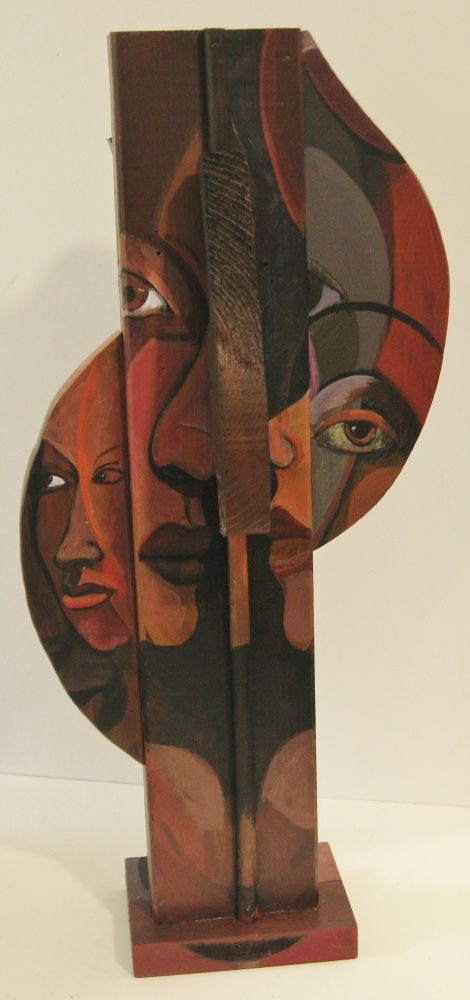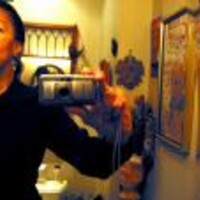Joyce Owens
Joyce Owens' portraits represent life's ups and downs
http://www.pjstar.com/article/20130608/News/306089892
By Leslie Renken
Joyce Owens' "Retro-racing Picasso #5," a sculpture made of wood, copper and acrylic, is on display at the Contemporary Art Center of Peoria.
Joyce Owens' creativity can't be confined to a single medium. A talented painter, she adds elements of collage to both her painting and her sculptures, and some of her paintings have very sculptural characteristics.
But even with the diversity of style, there is one word that can be used to describe all her artwork - they're all portraits, images of people. For Owens, it all comes down to human beings.
"Where do the problems come from? Who can solve the problems? It's all about choices, to me anyway," said Owens during a recent interview from her Chicago home. Owens, who has a master of fine art from Yale University, is an art professor and curator at Chicago State University. She has won numerous awards and has shown her work extensively in the U.S. and overseas.
"Joyce Owens: Retrospective" will be at the Contemporary Art Center of Peoria through June 28. The show features mixed media paintings, sculpture, and a series called "More than Skin Deep" which, through the clever use of folds, turns painted canvas into a sculptural experience.
When queried if she wrinkles the canvas before or after painting, Owens laughs. "Everybody asks me that question. Art is supposed to make you think, if that's what people think about, that's OK - I love it."
Owens likes to be challenged by her work, and painting canvases after they've been intricately folded is certainly challenging. But the folds also have connotations which give the work not only literal dimension, but figurative dimension as well.
"The folds represent life - life isn't smooth. If we were a chart it would be up and down, and then down more, and then way down, and then up," she explained. "The paintings are like life - it's not perfect."
The wrinkles also hint at the many dimensions in the human personality.
"All you know about me is what I'm telling you, but there are other layers to me," said Owens. "So the folds on the canvas represent the obstacles that we have to overcome, we have to learn to overcome the bumps."
Many of life's bumps are caused by false assumptions people have about each other.
"In the "More than Skin Deep" series I'm applying it to race. I've done other series where I'm trying to get people to look beyond the surface of human beings," said Owens. "Basically we're all pretty much the same. The range between human beings of different ethnic groups is very minimal. We really are all humans, and we bleed red blood - all of us do."
Owens didn't begin her career thinking she would focus on issues of gender and race, but as an African-American woman, it's a topic she simply couldn't avoid.
"I don't think there was ever a time when I didn't experience something sort of racial," Owens said. In the mid-1960s Owens was chosen to be the art editor on the school yearbook at the predominately white high school she attended in Philadelphia. She submitted artwork for the selection process, and with a name like Joyce Owens, she believes the teacher didn't know until he met her that she was African American. After meeting her he tried to choose a different student for the job, and when Owens' parents stepped in, Joyce volunteered to share the role with the other student - the two girls were friends.
"My feeling was that it was not necessarily because I was black, but because I wasn't Jewish," said Owens with a laugh.
As an adult living in Chicago's predominantly white Lincoln Park, Owens often experiences subtle - and sometimes not-so-subtle - moments of racism. It's only natural for the issue to surface in her work.
"I'm not a racist-sort-of-civil-rights-human-rights person, but I like to, in a very nice kind of way, I want you to think about this stuff," she said.
Owens' work often highlights historical aspects of the African-American experience not commonly known.
"The figures and faces are sometimes portraits from history that I publish in accessible forms for people who are not historians and may not know about African-American history beyond slavery, poverty, and the Civil Rights struggle," said Owens in her artist's statement.
Figures and faces are all woven together in Owens' work as a way to show the interconnectedness of all human beings.
"My hope is that - well, I think that it's stupid that we don't get along," said Owens.
While issues of race are addressed in Owens' work, they are not the only ideas related. For Owens, art is a way of working out problems.
"My work changes as I change," said Owens. "From self-centered toward looking toward the future. When I was pregnant I drew a lot of pregnant people. . . . When my mother died, I drew people underground, sort of coming apart. That was my sadness - artists channel what they cannot see."
While Owens' art often presents ideas that inspire thought, the artist says she works intuitively - she doesn't plan the subject matter out ahead of time.
"With art you don't know exactly what you are going for until you have done it, and then you have to sit down and think about it," she explained. "As much as art school helps you to learn how to mix colors, and about linear perspective . . . you have to use those skills in your own personal way. You have to learn to trust your instincts."
The artist has had years to tune into her intuition and hone her skills. She knew when she was in third grade that she wanted to be an artist, and she came from a family of creative people for which art was a way of life. And while she hasn't always earned her living making art, she's always made art.
"I tell people that I don't need special conditions to make art," said Owens. "I don't need to be in the right mood or have special music. I'm an artist, and I make art. I don't know what made me an artist - I just do it 'cause I can't stop myself."
If you go
- What: "Joyce Owens: Retrospective," artwork by Chicago-based artist Joyce Owens.
- When: Through June 28. Gallery hours are Tuesday through Saturday, 11 a.m. to 5 p.m., and until 8:30 p.m. on Fridays.
- Where: Contemporary Art Center of Peoria, 305 SW Water St., Peoria.
- For more information visit artcentr@mtco.com, or www.joyceowens.com.
Leslie Renken can be reached at 686-3250 or lrenken@pjstar.com. Follow her on Twitter, @LeslieRenken, and subscribe to her on Facebook.com/leslie.renken.
Jump to comments
Comments
Login with:


